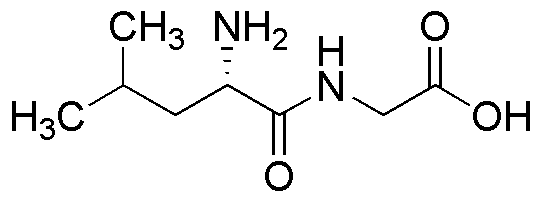Leu-Gly-OH is widely utilized in research focused on:
- Peptide Synthesis: This compound serves as a building block in the synthesis of peptides, which are crucial in drug development and biochemistry.
- Pharmaceutical Research: It plays a role in the formulation of therapeutic agents, particularly in developing treatments for metabolic disorders.
- Protein Engineering: Researchers use it to modify proteins, enhancing their stability and functionality for various industrial applications.
- Cosmetic Formulations: Its properties are leveraged in skincare products for their moisturizing and anti-aging benefits, appealing to the cosmetics industry.
- Biotechnology: It is used in the production of recombinant proteins, which are essential for vaccines and diagnostic tools.
General Information
Properties
Safety and Regulations
Applications
Leu-Gly-OH is widely utilized in research focused on:
- Peptide Synthesis: This compound serves as a building block in the synthesis of peptides, which are crucial in drug development and biochemistry.
- Pharmaceutical Research: It plays a role in the formulation of therapeutic agents, particularly in developing treatments for metabolic disorders.
- Protein Engineering: Researchers use it to modify proteins, enhancing their stability and functionality for various industrial applications.
- Cosmetic Formulations: Its properties are leveraged in skincare products for their moisturizing and anti-aging benefits, appealing to the cosmetics industry.
- Biotechnology: It is used in the production of recombinant proteins, which are essential for vaccines and diagnostic tools.
Documents
Safety Data Sheets (SDS)
The SDS provides comprehensive safety information on handling, storage, and disposal of the product.
Product Specification (PS)
The PS provides a comprehensive breakdown of the product’s properties, including chemical composition, physical state, purity, and storage requirements. It also details acceptable quality ranges and the product's intended applications.
Certificates of Analysis (COA)
Search for Certificates of Analysis (COA) by entering the products Lot Number. Lot and Batch Numbers can be found on a product’s label following the words ‘Lot’ or ‘Batch’.
*Catalog Number
*Lot Number
Certificates Of Origin (COO)
This COO confirms the country where the product was manufactured, and also details the materials and components used in it and whether it is derived from natural, synthetic, or other specific sources. This certificate may be required for customs, trade, and regulatory compliance.
*Catalog Number
*Lot Number
Safety Data Sheets (SDS)
The SDS provides comprehensive safety information on handling, storage, and disposal of the product.
DownloadProduct Specification (PS)
The PS provides a comprehensive breakdown of the product’s properties, including chemical composition, physical state, purity, and storage requirements. It also details acceptable quality ranges and the product's intended applications.
DownloadCertificates of Analysis (COA)
Search for Certificates of Analysis (COA) by entering the products Lot Number. Lot and Batch Numbers can be found on a product’s label following the words ‘Lot’ or ‘Batch’.
*Catalog Number
*Lot Number
Certificates Of Origin (COO)
This COO confirms the country where the product was manufactured, and also details the materials and components used in it and whether it is derived from natural, synthetic, or other specific sources. This certificate may be required for customs, trade, and regulatory compliance.

